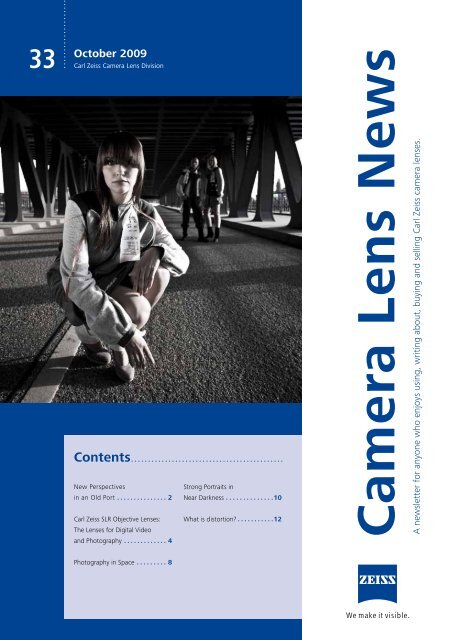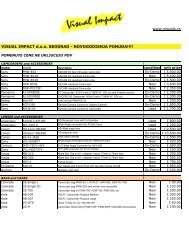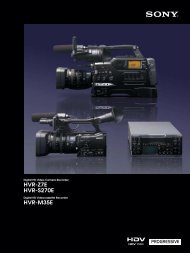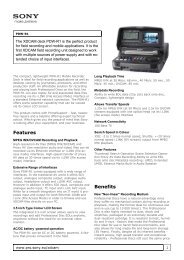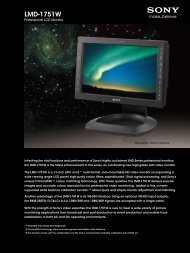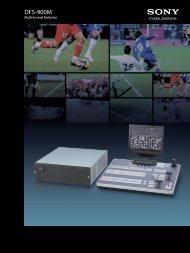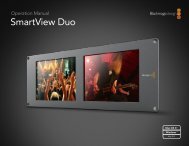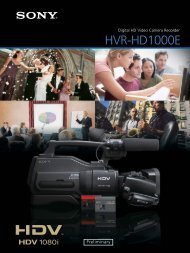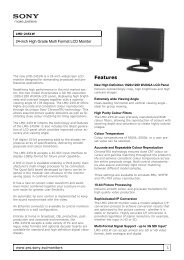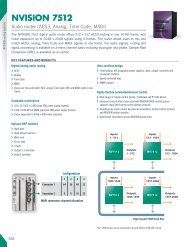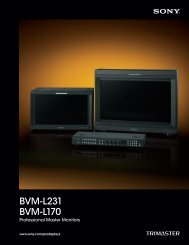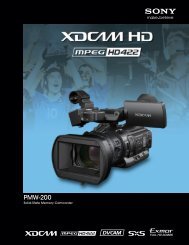Camera Lens News No 33
Camera Lens News No 33
Camera Lens News No 33
Create successful ePaper yourself
Turn your PDF publications into a flip-book with our unique Google optimized e-Paper software.
31 <strong>33</strong><br />
October 2009<br />
Carl Zeiss <strong>Camera</strong> <strong>Lens</strong> Division<br />
Contents<br />
New Perspectives<br />
in an Old Port 2<br />
Carl Zeiss SLR Objective <strong>Lens</strong>es:<br />
The <strong>Lens</strong>es for Digital Video<br />
and Photography 4<br />
Strong Portraits in<br />
Near Darkness 10<br />
What is distortion 12<br />
<strong>Camera</strong> <strong>Lens</strong> <strong>News</strong><br />
A newsletter for anyone who enjoys using, writing about, buying and selling Carl Zeiss camera lenses.<br />
Photography in Space 8
<strong>Camera</strong> <strong>Lens</strong> <strong>News</strong> <strong>No</strong> <strong>33</strong><br />
Carl Zeiss October 2009 Page 2<br />
New Perspectives in an Old Port<br />
Christian Merten works with striking<br />
perspectives and offbeat subjects.<br />
The Hamburg-based photographer,<br />
who specializes in fashion, cosmetics<br />
and portrait shots, tested the Carl<br />
Zeiss Distagon T* 3,5/18 ZE for<br />
Canon on a cloudy day in the Port<br />
of Hamburg.<br />
CLN: You recently put the new<br />
Distagon lens through its paces.<br />
What were your impressions<br />
Christian Merten: This super wideangle<br />
lens opens up a new dimension<br />
and hugely expands your photographic<br />
perspective – and I mean that<br />
both literally and figuratively! This is a<br />
lens that allows you to give free rein<br />
to your creativity on a wider scale,<br />
making exquisite little moments look<br />
really quite remarkable.<br />
CLN: What subjects and<br />
backdrops did you choose<br />
for the test<br />
Christian Merten: I am typically<br />
a photographer who specializes in<br />
fashion and beauty shoots, so I was<br />
keen to focus on this theme for<br />
the Distagon test, too. That‘s why<br />
I decided to get in touch with the<br />
fashion designer Birte Weiner, so that<br />
we could put together some ideas<br />
on how to showcase her collection<br />
in a novel and interesting way. She is<br />
a student at the Academy of Fashion<br />
and Design in Hamburg, and the<br />
clothes she designs cry out for airy,<br />
spacious settings. Where better to<br />
present clothes like that than the Port<br />
of Hamburg! Solid bridges, rustic-style<br />
backdrops, sweeping views...<br />
CLN: What were you expecting<br />
from the lens<br />
Christian Merten: ZEISS lens are<br />
renowned for their top-notch<br />
precision. So my expectations were<br />
correspondingly high for my outing<br />
with the new Distagon T* 3,5/18 ZE.
<strong>Camera</strong> <strong>Lens</strong> <strong>News</strong> <strong>No</strong> <strong>33</strong><br />
Carl Zeiss October 2009 Page 3<br />
CLN: So how did the<br />
lens perform in the Port of<br />
Hamburg tests<br />
Christian Merten: The lens totally<br />
fulfilled my expectations with regard<br />
to lens speed, sharpness and color<br />
rendition. It helped us to achieve top<br />
quality results that did justice to our<br />
original ideas. It lets you tinker with<br />
sharp focus and blur, and the lens<br />
copes brilliantly with backlighting.<br />
Colors are superbly rendered in natural<br />
tones. What a difference in quality<br />
compared to the results produced<br />
by other lenses! I am genuinely<br />
impressed; the Distagon T* 3,5/18 ZE<br />
has really been quite a revelation.<br />
And it’s great to be one of the first<br />
people to have tried out the very<br />
latest ZEISS lens!<br />
Following the Distagon<br />
T* 3,5/18 ZE, Carl Zeiss now<br />
presents the second super wide<br />
angle lens with an EF bayonet:<br />
the Distagon T* 2,8/21 ZE is ideal<br />
for architecture photography<br />
and landscapes.
<strong>Camera</strong> <strong>Lens</strong> <strong>News</strong> <strong>No</strong> <strong>33</strong><br />
Carl Zeiss October 2009 Page 4<br />
Carl Zeiss SLR Objective <strong>Lens</strong>es:<br />
The <strong>Lens</strong>es for Digital Video and Photography<br />
The briefly flashing eyes of<br />
the hero, the crumbling asphalt<br />
of the urban street canyon in<br />
which he he‘ll soon vanish, the<br />
unknown being gradually appearing<br />
in the foreground. Narration<br />
through pictures is always a matter<br />
of the technique used. Details<br />
and effects, such as the look of<br />
the film or the follow focus captivate<br />
the audience and pull the<br />
observer right into the action.<br />
Amazing effects can be realized<br />
in films and photography using<br />
the SLR objective lenses made<br />
by Carl Zeiss if you capitalize on<br />
their special features and follow<br />
one or two tips.<br />
Thoralf Abgarjan produces<br />
multimedia content for music and<br />
advertising: music composition<br />
and production for Expedia.de,<br />
Exquisa, Erdinger, ADAC, ÖAMTC,<br />
film projects for Koch-Universal,<br />
Musik-Media-Verlag, YAMAHA,<br />
ADAC, ÖAMTC and many others.<br />
Video or film look<br />
The unmistakable look of moving<br />
pictures is the result of tiny details:<br />
for example, the color fidelity that<br />
is particularly evident in the hues of<br />
skin color, the specific aesthetics of<br />
movements captured at 24 frames<br />
per second as compared to the<br />
frames of TV, and the lower depth<br />
of field which makes the cinematic<br />
presentation of objects possible.<br />
The low depth of field is a particularly<br />
attractive design tool, but at the same<br />
time a true challenge of digital cinematography.<br />
When the surroundings<br />
are imaged out of focus, the view of<br />
the observer is automatically directed<br />
to a point of interest which the cameraman<br />
can deliberately extract from<br />
the surroundings.<br />
For a long time, low depth of field<br />
remained a domain of 35 mm film.<br />
This is due to the laws of physics as<br />
the comparatively small sensors of<br />
digital video cameras (1/3 to 2/3 of<br />
an inch in size) do not allow for low<br />
depth of field. Consequently, 35 mm<br />
film allows a person in a room to be<br />
set apart from the furnishings by the<br />
deliberate use of low definition.<br />
Depth of field via adapters:<br />
high effort, low-light<br />
transmission power<br />
One way of attaining targeted<br />
blurring in digital films is the use<br />
of DOF adapters (DOF: depth of<br />
field). The best known approach<br />
to this issue was first provided by<br />
P&S-Technik (Germany) and later<br />
included in the products of Redrock<br />
(USA) and SG-Pro (England). The<br />
digital video camera captures a<br />
35 mm intermediate image that is<br />
reproduced on a rotating ground<br />
glass screen by a high-speed camera<br />
lens. Particularly popular in this<br />
context are the purely manuallyoperated<br />
Canon-FD lenses and the<br />
manual Nikon lenses of the past.<br />
The moving picture thus attains a soft<br />
aesthetic appearance, a grainy look –<br />
a smooth, non-digital overall image<br />
with no hard edges. The grain of the<br />
ground-glass screen introduces blur<br />
as a result of the motion blur of the<br />
screen. In this context, the rotating<br />
speed and the type of surface must<br />
be selected carefully to ensure that<br />
the image does not appear mushy or<br />
diffuse. Since the intermediate image<br />
needs to be flipped – i.e. unreversed<br />
and upright – another optical component,<br />
the flip module, is required.<br />
The back focus – i.e. focusing onto<br />
the imaging surface of the screen –<br />
must be set and fixed with high<br />
precision by the filmmaker to ensure<br />
that the images do not blurred.<br />
This procedure also generates the<br />
desired depth of field in digital films.<br />
One crucial drawback is that the<br />
complex set-up leads to a loss of light<br />
intensity equivalent to up to three<br />
aperture stop settings. Considering<br />
that HD video cameras already have<br />
difficulties in low light conditions,<br />
this is a further shortcoming.
<strong>Camera</strong> <strong>Lens</strong> <strong>News</strong> <strong>No</strong> <strong>33</strong><br />
Carl Zeiss October 2009 Page 5<br />
Depth of field without tricks:<br />
the full-format sensor is key<br />
The Canon EOS-5D Mark II is the first<br />
camera to enable cinematographic<br />
depth of field without additional loss<br />
of light intensity, a feature that makes<br />
it truly useful for professional filmmaking.<br />
The most interesting feature<br />
of the EOS-5D-Mark II to the video<br />
photographer is optical imaging onto<br />
a full-format sensor with the same<br />
geometric dimensions as 35 mm<br />
analog film. The recording is in full<br />
HD: progressive 1080p.<br />
The camera initially utilized some kind<br />
of semiautomatic system which made<br />
it quite difficult to manually set the<br />
aperture stop. This was impractical<br />
for professional use, but this handicap<br />
was remedied with the release of<br />
the eagerly awaited firmware update<br />
1.1 in June 2009. Aperture stop, ISO<br />
sensitivity and exposure time can now<br />
be set independently of each other<br />
in the manual mode. For filmmaking,<br />
the camera features sensational<br />
low light behavior. Even at night,<br />
exposures can be taken without any<br />
significant noise – provided you have<br />
a high-speed lens. One drawback is<br />
that the camera only offers a fixed<br />
frame rate of 30 fps, making users<br />
anticipate the next firmware update<br />
that will accommodate the frame<br />
rate of 25 fps in Europe.<br />
Fixed focal length or zoom<br />
Dedicated objective lenses for<br />
video-photography<br />
Fixed focal length lenses have<br />
tremendous advantages over zoom<br />
lenses – especially in digital videography.<br />
Their speed is at least twice<br />
as high: the Canon EOS 5D Mark II<br />
excels through its superior low<br />
light behavior. It is therefore selfevident<br />
that only the fastest lenses,<br />
i.e. 1.4 - 1.2, should be used with<br />
the unit because even the most<br />
sensitive sensor is useless if too little<br />
light passes through the lens.<br />
Working in full HD, you need to have<br />
razor-sharp images. Fixed focal length<br />
lenses produce much sharper images<br />
than zoom lenses and tend to exhibit<br />
less distortion at the periphery. This<br />
applies, in particular, to the Zeiss T*<br />
lenses. Moreover, fixed focal length<br />
lenses tend to exhibit substantially<br />
less „pumping“ than zoom lenses.<br />
Pumping is observed when the geometry<br />
of the object appears to change<br />
while focusing. However, only the<br />
sharpness should shift while focussing,<br />
not the dimension of the image<br />
recorded.<br />
Common and important<br />
fixed focus lengths:<br />
The most important fixed focal<br />
lengths are 50 mm (the normal lens),<br />
28 mm (wide-angle for landscapes<br />
and indoors), and the 85 mm telephoto<br />
lens which excels in portrait<br />
photography and „over-shoulder<br />
images“ in which a person in the<br />
foreground is deliberately kept out<br />
of focus.<br />
Autofocus or manual focus<br />
A film-maker uses selective focus<br />
mainly for scene design purposes<br />
and therefore as a creative element<br />
of style. For this reason, camera<br />
lenses are used in the manual mode<br />
exclusively in videography even if<br />
they feature autofocus. In addition,<br />
all autofocus strategies fail in high<br />
Fig. 1: Canon EOS-5D-Mark II equipped with the<br />
Planar T* 1.4/50 ZE and Chrosziel Follow Focus<br />
Fig. 2: Canon EOS-5D-Mark II used as a videocamera:<br />
ready-for-use Chrosziel rig equipped with<br />
the Planar T* 1.4/50 ZE, Chrosziel Follow Focus,<br />
Redrock Mattebox, and Marshall Field Monitor<br />
quality videography such as measu-ring<br />
fields and face recognition.<br />
Although lenses for SLR cameras<br />
can be switched to manual mode,<br />
this is basically only a minor application.<br />
They often run imprecisely, or<br />
even with substantial play in the<br />
worst case, and the focal points that<br />
are so important for videography<br />
are difficult to reproduce.<br />
Purely manual lenses such as the<br />
ZEISS lenses are designed for manual<br />
focal adjustment. They offer much<br />
better precision than manually operated<br />
autofocus lenses.
<strong>Camera</strong> <strong>Lens</strong> <strong>News</strong> <strong>No</strong> <strong>33</strong><br />
Carl Zeiss October 2009 Page 6<br />
Why lenses from ZEISS are<br />
particularly well-suited for<br />
videography:<br />
• Carl Zeiss lenses are characterized<br />
by their high speed and are designed<br />
solely for use as manually adjusted<br />
lenses – ideal for videography.<br />
• They produce razor-sharp images<br />
and enable selective focus. Their<br />
maximum aperture of 1.4 is optimal<br />
as larger aperture stops such as 1.2<br />
have such a small focusing range<br />
that the overall image appears blurred.<br />
Limitation to 1.4 is therefore a<br />
realistic value.<br />
• The lenses come with an excellent<br />
manual focus ring whose motion is<br />
perfectly suited for follow-focus.<br />
• The lenses have a special look,<br />
the images appear fresh and the<br />
bokeh effect (area of blur) appears<br />
very classy. The bokeh plays a particularly<br />
important role in the overall<br />
impression of the image.<br />
Accessories for videographers<br />
As soon as you start working with<br />
the new ZEISS lenses, you develop a<br />
desire for selective focus adjustment.<br />
The following accessories are helpful<br />
and recommended for this:<br />
1. Rig, lifting the camera to the<br />
standardized level of the optical axis<br />
and facilitating the attachment of<br />
follow focus and matte box<br />
2. Follow focus: despite the precise<br />
motion of the focus ring, it is difficult<br />
to smoothly and precisely adjust<br />
the focus using the lens ring. The<br />
follow focus should be as precisely<br />
as possible. Only then can the capabilities<br />
of these sophisticated lenses<br />
be fully utilized.<br />
3. Matte box to eliminate stray light<br />
and as a holder for filters such as<br />
Fig. 3: The Planar T* 1.4/50mm equipped with<br />
gear ring (Chrosziel) for the follow focus. The<br />
reverse gear drive shown on the left is extremely<br />
important for intuitive operation.<br />
ND (neutral density, for situations<br />
with too much light, sunlight, snow,<br />
etc.), polarizing filters (intensify sky,<br />
eliminate reflections) etc.<br />
4. Monitor for focus assessment,<br />
preferably with „peaking“ display of<br />
the focal point using other colors<br />
Based on the technical data alone, it<br />
is difficult to explain the differences<br />
in pricing of the accessories which<br />
are substantial in some cases. It’s the<br />
details that count: for example the<br />
direction of focus shift. The follow<br />
focus supplied by Munich-based<br />
Chrosziel has a reverse gear drive<br />
which I find extremely important.<br />
The intuitive component offered by<br />
a reverse gear drive should not be<br />
underestimated. Intuitive means that<br />
you rotate forwards to move the<br />
focal point farther away. The precision<br />
of the rig is evident from the<br />
firm and fixed attachment of the<br />
parts and by how easy they are to<br />
disassemble when needed without<br />
hurting your hands.<br />
Until now, Chrosziel has supplied a<br />
fixed gear ring for the standard zoom<br />
of Canon. The fixed ring that is<br />
seated directly on the lens ensures<br />
optimal precision that vastly exceeds<br />
the precision of flexible universal<br />
rings. Since the cameras are usually<br />
sold with this zoom, it is very widespread.<br />
However, it is not the optimal<br />
choice for high quality videography.<br />
Since I used to work with the DOF<br />
adapter quite a bit in the past, I<br />
became familiar with the advantages<br />
of the Canon FD lenses for purely<br />
manual focusing. It was therefore a<br />
great joy to me when purely manually<br />
focusing ZEISS lenses finally became<br />
available for Canon cameras. For<br />
my applications, it would also be<br />
ideal to have a manual aperture ring.<br />
Currently, the aperture stop is controlled<br />
electronically by the camera<br />
which is a slight drawback.<br />
Chrosziel was kind enough to<br />
custom-manufacture a gear ring for<br />
my 50 mm lens – I cannot imagine<br />
better customer service. It has come<br />
to my attention that Chrosziel is<br />
considering adding fixed gear rings<br />
to their product line for ZEISS lenses.<br />
The crank on the follow focus is also<br />
very convenient and important to<br />
me: it makes it much easier for me to<br />
overcome the limited range of angles<br />
that can be set with my left hand.<br />
The monitor with peaking function<br />
is indispensable as it allows me to<br />
assess the focus properly. Chrosziel<br />
supplies the matching solution in an<br />
additional kit for this application as<br />
well.<br />
Objective lenses for<br />
videography and photography<br />
The strengths of the lens – such as<br />
high-speed, razor-sharp images, a<br />
noble look and beautiful background<br />
blur – can also be advantageous to
<strong>Camera</strong> <strong>Lens</strong> <strong>News</strong> <strong>No</strong> <strong>33</strong><br />
Carl Zeiss October 2009 Page 7<br />
Fig. 4: Carl Zeiss SLR lenses are ideally suited for<br />
precise follow focus.<br />
Fig. 5: The crank on the follow focus is a necessity,<br />
especially for camera lenses.<br />
Fig. 6: The matte box accommodates the filters<br />
and provides protection against stray light.<br />
Fig. 7: The matte box must be sealed tightly on<br />
the objective lens (here with neoprene) to prevent<br />
uncontrollable reflections from forming on the<br />
surfaces of the filters.<br />
Fig. 8: The fixed gear ring on the lens.<br />
Fig. 9: Free-hand night exposure: made possible<br />
only by the high speed of the Zeiss 50 mm lens.<br />
normal photography. Photographers<br />
must be aware of the following:<br />
• Snapshots are not a strength of<br />
ZEISS lenses since focusing usually<br />
takes more time than with autofocus<br />
lenses.<br />
• Planar-T* lenses are ideal for fully<br />
designed images with high aesthetic<br />
appeal.<br />
• The imaging performance is so<br />
good and the images so sharp that<br />
checking via the measuring field<br />
of the camera does not provide<br />
sufficiently accurate feedback although<br />
it generally works. The manual<br />
assessment of focus via the viewfinder<br />
is also problematic, but the<br />
„live view“ feature can help. It<br />
magnifies the image in the display<br />
by a factor of 5 to 10 and you can<br />
see how far the measuring field<br />
determination or rough setting using<br />
the viewfinder are from the true focal<br />
point. While this permits perfectly<br />
focused images, it takes time. Having<br />
a good monitor with a „peaking“<br />
feature significantly simplifies focusing<br />
in videography.<br />
Conclusion<br />
In my experience, the new SLR lenses<br />
from Carl Zeiss are first class and<br />
unparalleled in digital videography<br />
with the Canon EOS-5D-Mark II. As<br />
lenses for purely manual focussing,<br />
they are perfectly suited for this<br />
application. The brilliant look of the<br />
lenses, their crispness, and the stylish<br />
bokeh are excellent additions for<br />
photography unless you talking about<br />
snapshots and not well-balanced,<br />
perfectly-designed pictures for which<br />
you can takes your time. <strong>No</strong>thing<br />
here is left to automatic controls!<br />
And this feature is the strength of<br />
these lenses. The photographer<br />
has everything under control and<br />
has the opportunity and the means<br />
to produce very good pictures.
<strong>Camera</strong> <strong>Lens</strong> <strong>News</strong> <strong>No</strong> <strong>33</strong><br />
Carl Zeiss October 2009 Page 8<br />
Photography in Space<br />
“That‘s one small step for man, one the position of extremely small, onekilogram<br />
satellites. The camera will<br />
giant step for mankind“ – words<br />
that would go down in history when be integrated into nano-satellites<br />
Neil Armstrong became the first where it will take pictures of the stars<br />
human to set foot on the moon in during flight. A computer program<br />
1969. His baggage included a lens will then compare the size, brightness<br />
from Carl Zeiss. Deployed on a and arrangement of the celestial<br />
Hasselblad camera, it captured what bodies in the images with known<br />
had never been seen before – the stars listed in a NASA star catalog.<br />
dusty surface of the moon, its barren The program can determine precisely<br />
landscape pockmarked by numerous where the satellite was when it took<br />
meteorites, the first footprints in the picture. The new star camera<br />
the Sea of Tranquility. NASA also is based on an SDL camera model<br />
used cameras with Carl Zeiss optics known for its particularly accurate<br />
for later trips to the moon. <strong>No</strong>w, 40 target localization and extremely low<br />
years later, the Space Dynamics energy consumption. The prototype<br />
Laboratory (SDL) at the University will demonstrate its capabilities<br />
of Utah and the Washington Naval during a test flight on the International<br />
Space Station.<br />
research Laboratory (NRL) are once<br />
again preparing a ZEISS lens for<br />
space – albeit with a different The costs and development time<br />
mission in mind.<br />
for such a camera are enormous.<br />
The scientists wanted to use existing<br />
The two institutes jointly developed lenses and modify them for the<br />
the prototype of a miniature star current job in order to keep costs to<br />
camera that will be used to determine a minimum. They put to the test<br />
Scientists use existing ZEISS lenses and modify them to fit their needs.<br />
three lenses from different manufacturers.<br />
The Planar T* 1,4/85 ZF-I was<br />
quickly identified as the best of the<br />
three. In the industrial version of the<br />
ZF lenses, the focus ring and aperture<br />
can be fixed with just five screws.<br />
Furthermore, Carl Zeiss supplied the<br />
institutes with very detailed information<br />
on the lens, which was vital<br />
for the successful modification. The<br />
first-class quality of the lenses, for<br />
which Carl Zeiss is known the world<br />
over, also played a key role.<br />
A lens has to take a lot of punishment<br />
in space. Mechanical forces during<br />
launch, temperature fluctuations,<br />
pressure and the vacuum of space<br />
demand the utmost. Like the moon<br />
lens for Apollo 11, the Planar<br />
T* 1,4/85 ZF-I was modified to survive<br />
in these extreme conditions.<br />
The researchers first took the lens<br />
completely apart, and removed the<br />
grease, lubricants and cements.<br />
These substances, which normally<br />
ensure that the lenses remain in<br />
one piece and work properly, would<br />
contaminate the optics in space.<br />
The scientists then took precautions<br />
to maintain optimal pressure compensation.<br />
To do this, they aired out<br />
the spaces between the single lens<br />
elements and bored holes in the lens<br />
housing to enable air exchange.<br />
Finally, they removed the diaphragm<br />
that is not needed for the special<br />
mission of the camera. After all,<br />
every gram and every millimeter<br />
counts when it comes to adapting<br />
the camerato the size and weight<br />
limits of the nano-satellites.
<strong>Camera</strong> <strong>Lens</strong> <strong>News</strong> <strong>No</strong> <strong>33</strong><br />
Carl Zeiss October 2009 Page 9<br />
The greatest challenge was properly<br />
reassembling the lens after the<br />
corrections. Excellent image quality<br />
requires each part of the lens to be<br />
perfectly aligned and matched to<br />
the other components. During production,<br />
Carl Zeiss therefore conducts<br />
extensive measurements and quality<br />
controls after each step to ensure<br />
the high quality.<br />
As a result, a ZEISS lens is once<br />
again making its way into space.<br />
It is uncertain if it will ever return<br />
to the earth – weight limits have<br />
forced astronauts to leave many<br />
cameras and lenses behind over<br />
the past 40 years.<br />
Additional holes are drilled to enable air exchange which enables optimal pressure compensation.<br />
The finished camera module must deliver excellent image quality despite the modifications.
<strong>Camera</strong> <strong>Lens</strong> <strong>News</strong> <strong>No</strong> <strong>33</strong><br />
Carl Zeiss October 2009 Page 10<br />
Strong Portraits in Near Darkness<br />
There’s just something about abadoned<br />
buildings. Where people used to<br />
live and work; where the machines<br />
have long been silent. Silence spreads<br />
like wildfire. The relics of the past are<br />
literally peeling, decaying, and covered<br />
in leaves and dust, but somehow<br />
still present. When I am out on the<br />
road, I am always on the lookout for<br />
old factory buildings, warehouses<br />
and deserted train stations. If I notice<br />
an interesting site, I immediately<br />
think of ways to take pictures. It<br />
often takes a bit of courage to climb<br />
in, get dirty and explore the old ruins.<br />
Every discovery is exciting: what is<br />
hiding behind the next door<br />
Because of my passion for dilapidated<br />
buildings, I took my ZEISS Planar<br />
T* 1,4/50 ZE and Distagon T* 2,8/21 ZF<br />
lenses with me into the abandoned<br />
buildings and tested how well<br />
they capture the room and work to<br />
perfection with so little light.<br />
The first shoot was in an empty<br />
structure near Stuttgart. The light<br />
was not good, however, the Planar<br />
T* 1,4/50 ZE certainly proved its<br />
metal in the gloomy ambience. I<br />
obtained high image quality even at<br />
full aperture. When taking portraits,<br />
I like to work with the contrast<br />
created between focused and blurred<br />
areas because it adds a very distinctive<br />
character to the picture.<br />
I liked the strong, selective definition<br />
achieved with the lens. I was also<br />
impressed by the astoundingly natural<br />
color rendition.<br />
I then tested the Planar T* 1,4/50<br />
for pictures in an old train station in<br />
Stuttgart. In portrait photography,<br />
the objective is to embed the models<br />
in their environment, to come to<br />
terms with the lighting and to find<br />
the right image composition. While<br />
taking pictures against this backdrop,<br />
I wanted the few light areas to lift<br />
the model out of the darkness. The<br />
lens did a very good job of capturing<br />
the contrasts, resulting in really breathtaking<br />
images. I was impressed.<br />
Finally, I used a Distagon T* 2,8/21<br />
ZF in an old building near Berlin. I<br />
usually use 50 mm lenses for portraits<br />
because they make it possible to<br />
generate a feeling of closeness.<br />
However, if space is to be a key<br />
element of the composition, I need<br />
a wide-angle lens that captures the
<strong>Camera</strong> <strong>Lens</strong> <strong>News</strong> <strong>No</strong> <strong>33</strong><br />
Carl Zeiss October 2009 Page 11<br />
dimensions. The super wide-angle<br />
enabled me to completely capture<br />
the large room and infuse the image<br />
with enormous depth. Despite the<br />
difficult lighting conditions, I was<br />
once again able to achieve fantastic<br />
image quality.<br />
The fixed focal length of the ZEISS<br />
lenses turned out to be perfect for<br />
portraits. With manual focusing,<br />
you work more carefully and know<br />
precisely when you press the trigger.<br />
As a result, you are more likely to<br />
capture that special moment. There<br />
are certainly situations, such as glare,<br />
when manual focusing can be a bit<br />
tricky. However, the precise setting<br />
possibilities are a clear advantage<br />
when I want to specifically showcase<br />
a subject. My models should not<br />
have empty faces but appeal to and<br />
engage the observer. People, composition,<br />
details, light and colors must<br />
interact perfectly. When I succeed<br />
in showing character and vibrancy,<br />
the portrait is a success.<br />
Delia Baum takes amazing<br />
portraits in the nooks and crannies<br />
of abandoned buildings. The<br />
young photographer from<br />
Leonberg, Germany, tested the<br />
Planar T* 1,4/50 ZE and Distagon<br />
T* 2,8/ 21 ZF lenses with a Nikon<br />
D3 in her favorite environment.<br />
At first she found working with a<br />
fixed focal length a bit unusual,<br />
but soon became a fan. Delia<br />
Baum is 22 and is currently learning<br />
to be a photographer at the<br />
René Staud Studio in Leonberg.
<strong>Camera</strong> <strong>Lens</strong> <strong>News</strong> <strong>No</strong> <strong>33</strong><br />
Carl Zeiss October 2009 Page 12<br />
What is distortion<br />
The majority of camera lenses<br />
produce images in line with the laws<br />
of central perspective. This kind<br />
of projection of three-dimensional<br />
space onto a two-dimensional image<br />
surface is also called gnomonic<br />
projection. This Greek term (gnomon<br />
= gnomon = shadow-producing rod)<br />
denotes a type of sundial because,<br />
as with a sundial, an image point is<br />
produced by connecting a point in<br />
the object space to the center of the<br />
projection using a straight line; the<br />
image point is where this straight line<br />
intersects the flat projection surface.<br />
The center of projection of the image<br />
is the tip of the rod used by Dürer‘s<br />
artist to draw attention to the charms<br />
of the young lady in this picture. The<br />
projection surface is the frame fitted<br />
with a grid placed between the two<br />
and is used by the artist to transfer the<br />
image points onto his drawing paper<br />
with the proper perspective.<br />
The center of projection of camera<br />
lenses is their entrance pupil, i.e.<br />
the image of the aperture stop<br />
viewed from the front. When taking<br />
panorama photos, it is necessary<br />
to swivel around the entrance pupil<br />
to ensure that objects in the foreground<br />
and background are not<br />
shifted with respect to each other.<br />
is not the physical aperture stop, but<br />
rather its virtual image – and as such<br />
may even be situated outside the lens<br />
altogether. This is often the case with<br />
short telescopic lenses.<br />
The gnomonic (central perspective)<br />
projection has a special feature where<br />
all straight lines of the object space<br />
are reproduced in the image as a<br />
straight line regardless of where they<br />
are situated and to where they are<br />
projected.<br />
Distortion is defined as an image<br />
aberration in which this property is<br />
no longer exactly fulfilled. A lens that<br />
exhibits distortion produces slightly<br />
warped images of lines that do not<br />
pass through the center of the image.<br />
<strong>Camera</strong> <strong>Lens</strong> <strong>News</strong><br />
A newsletter for all who use, buy, sell,<br />
like, report about and are interested in<br />
Carl Zeiss camera lenses.<br />
All information in <strong>Camera</strong> <strong>Lens</strong> <strong>News</strong> is<br />
accurate to the best of our knowledge at<br />
the time of publication.<br />
Publisher:<br />
Carl Zeiss AG<br />
<strong>Camera</strong> <strong>Lens</strong> Division<br />
Marketing<br />
73446 Oberkochen<br />
Germany<br />
Phone: +49 (0) 7364/ 20-6175<br />
Email: photo@zeiss.de<br />
Internet: www.zeiss.de/photo<br />
This special point is often also called<br />
the nodal point, but it has a very<br />
different meaning in optics. There<br />
is nothing particularly mysterious<br />
about the entrance pupil either, since<br />
anyone can see it without any special<br />
aids and estimate its approximate<br />
position. However, the entrance pupil


